We had not come to Kigoma just to experience an exciting bus ride. The city was the base for our trip to Gombe National Park, which is located at the coast of Lake Tanganyika, about 2.5 hours by boat north of Kigoma. Already before starting our adventure in Peru, we had organized our safaris and prebooked a guide, Hussein. So now we were in the quite new position of not having to plan anything – it was nice after all not to have to worry about how to go on.
Our aim in Gombe was to see the chimpanzees. We were told that you have to walk 2-3 hours trough the forest and that sometimes you need a second try the next day. Usually you only get a glimpse of them while they jump through the trees. So we started our long walk. After maybe ten minutes our guide asked a researcher, who was responsible to keep track of the chimps, whether he had an idea in which direction to go to see them. He simply nodded indifferently towards a trail 20 meters away: a whole family was sitting here, perfectly visible on the ground and relaxed. At least since Jane Goodall this group is used to humans, so it turned out to be pretty easy to watch them. In fact, they are fascinating animals. They just sat there, the babies climbed onto the adults, they played and picked the fleas. Chimpanzees are flexible when it comes to food: they eat plants, fruits but also some baby baboons. They even mix meat with some vegetables, so their menu is much more sophisticated than in any Tanzanian restaurant. Sometimes, they eat Amarula, a fruit that makes them drunk and helps enjoying their time even better. They have such a relaxed life that we wonder which of the chimps was the first to have the stupid idea of starting the evolution towards a human being …. Given we achieved our goal that quickly, we spent the rest of the day walking to a waterfall and lying at the wonderful beach near the research station.
The next day we went back to Kigoma to start the journey to Mpanda. After the disappointment with African buses, we preferred relying on good old German technique – we embarked the MV Liemba. “Good”, “old” and “German” all are to be taken literally: the ship just made her way without any defects. She is the oldest passenger ship currently in use worldwide and she was indeed built by the Germans during the colonial episode. Roughly she has the same age as the Titanic. Built in 1913 she started her service as battle ship on Lake Tanganyika in 1915 under the name “Graf Goetzen”. Before retreating, the Germans scuttled the ship but the British raised her again. Since 1927 she serves almost without interruption as a passenger and cargo ship. Given there is only one other boat going to Congo, she is nearly the entire infrastructure at Lake Tanganyika. Every other week she makes her way to Zambia and that is the event of the month in the region.
We shared the Liemba with maybe 20 other tourists in private cabins, about 500 Africans on the lower decks, tons of cargo, thousands of pineapples and an equal amount of bananas and cockroaches. It was tough how many people they got into that boat, most of them penned up in a windowless room without escape routes or bathroom, where they had to dwell for two days. Some preferred to sleep between or on the cargo outside. How different was the life on the upper deck: We had spacious cabins for two persons and could enjoy the nostalgic atmosphere on the Liemba. In Europe you find something like this only in museums, here it was alive! We ate at the restaurant, talked to the Second Chief Commander (who proudly told us the Liemba was still a German ship, a statement we would not have dared to utter) and sat outside in the sun. But when we had to disembark, we realized we were still in Africa – the little village we went to had no landing stage, so we were picked up by some small boats we privately called “Lampedusa Service”. In the middle of the lake, from the door of the Liemba, we had to jump one meter into the small boat and then hurry to the shore before the vessel could fill up with water completely. We just arrived in the middle of nowhere, where Africa is as pristine as it can be: extremely dusty, isolated, without villages of more than a dozen families, without electricity or tap water, dry and wide but also charming. There at Ikola, Hussein came to pick us up and we drove two hours on small, dusty roads to Mpanda, passing little wooden villages and a lively market.
From Mpanda, we drove to Katavi National Park, number three in size in Tanzania and home to as many animals as famous Serengeti, but with fewer visitors per year than in Serengeti per day. Obviously, the staff at the Bandas was not used to visitors as it was the worst accommodation with the worst service ever. Sorry for disturbing your leisure, a cold egg and three pieces of old bread from the German colonial era is NOT a decent breakfast for three people. Luckily, everything else was great. It was our first “real” safari and we cannot compare but to us it seemed just perfect. It was so easy to see the animals, we needed less than two hours to discover hippos, elephants, crocodiles, antelopes, giraffes, buffaloes, monkeys, birds and lions. The density was probably even higher than in every zoo, no matter where you looked, you would at least see an elephant or a hippo. It was a great safari and we had the park nearly for our own. During a full day game drive we saw two other Jeeps, one at the headquarters and the other one was a researcher. On the second day we did a walking safari which gave the opportunity not only to watch but to really experience the nature. Accompanied by a ranger armed with a riffle (for security, still he has NEVER used it until now), we walked for 4 hours at Lake Katavi, being “surrounded” by hippos, elephants, monkeys, storks and eagles. Unfortunately, we had to rush away from this remote area a bit faster than expected – have a look at our blog the next days to know the reason why.
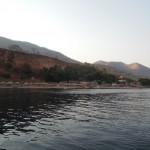
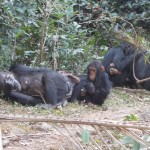
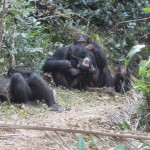
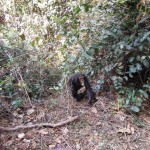
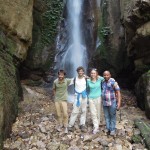
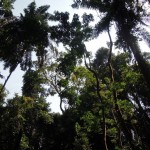
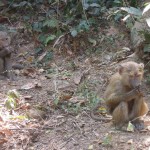
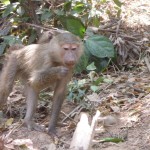

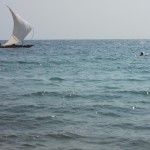
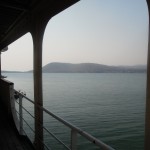
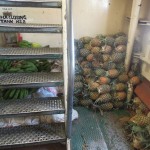
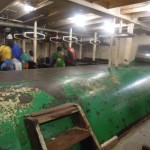
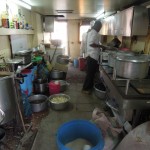
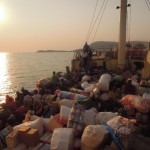

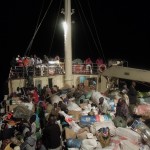
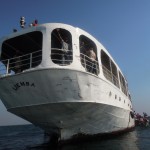



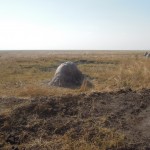
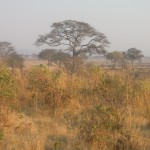
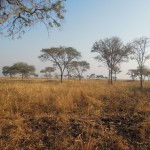
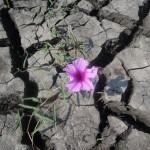
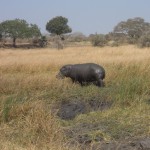
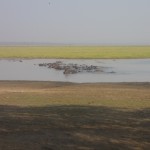
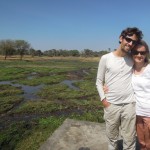
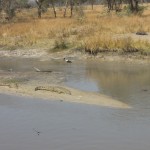
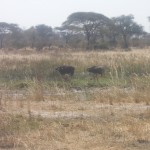
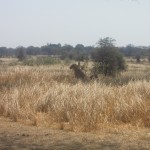
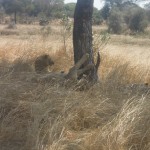
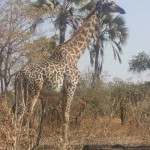
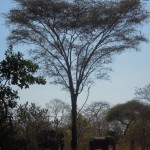
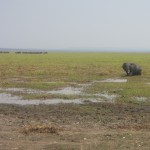
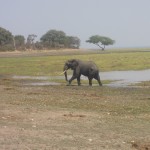
Très drôle, very funny indeed, tes deux réflections “… so their menu is much more sophisticated than in any Tanzanian restaurant …” et “… They have such a relaxed life that we wonder which of the chimps was the first to have the stupid idea of starting the evolution towards a human being …”
Et quel suspense pour la suite de tes récits … “Unfortunately, we had to rush away from this remote area a bit faster than expected …” et on sait pas encore pourquoi..!!..
Hi, ihr Drei! Das war ja mal wieder ein sehr inhaltsvoller Reiseabschnitt, die Fotos sind einfach toll. MV Liemba erinnert mich ein wenig an ein Sklavenschiff mit den Bedingungen im Unterdeck. Gute Spannung aufgebaut am Schluss:-) Gute Weiterreise wünscht euch Thea